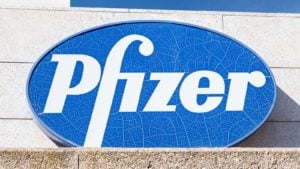Bargain stocks are making a comeback, as growth stocks are now seen as a bubble on the brink of bursting. Amid this shift, value stocks are attractive bets, offering healthy long-term upside and an income stream at attractive prices. These stocks, overshadowed in a market dazzled by high-fliers, present a unique opportunity for diversification and value.
However, pinpointing the best-value stocks is fraught with potential pitfalls. Value traps – stocks appearing cheap – are usually cheap for a reason. Therefore, due diligence is pivotal. Ensuring that a company offers value and a sustainable and viable path forward is essential in its appeal as a top-value stock. This approach mitigates risk and aligns with the strategic pursuit of long-term investment gains.
Bargain Stocks To Buy: Pfizer (PFE)

- % Below 52-week high: 36.3%
Pfizer (NYSE:PFE) stock has taken a hammering over the past year, shedding more than 30% of its value. The negative sentiment surrounding PFE stock is mainly due to falling revenues from its COVID-19 vaccine. Despite this setback, it’s imperative to gauge that the market’s reaction may be overly pessimistic. Moreover, when layered with its impressive 6% dividend yield, PFE stands out as a compelling value investment opportunity.
Furthermore, with a comprehensive portfolio extending far beyond just its vaccine offerings, PFE’s long-term bull case is mighty compelling. In fact, with nine new molecular entities recently approved by the FDA, Pfizer is paving the way for a promising 2024. Additionally, with a robust pipeline of drugs in multiple development stages and expected revenue growth of 3% to 5% in 2024, PFE is mighty attractive at current levels.
Moreover, Pfizer’s strategic acquisition of Seagen is a game-changer for its oncology segment, with the firm projecting a massive $25 billion in incremental sales from these initiatives by 2030.
AT&T (T)

- % Below 52-week high: 15.1%
Telecommunications behemoth AT&T (NYSE:T) has efficiently navigated through turbulent waters marked by liquidity concerns. Yet, its commitment to paring down its debt load has paid off, substantially reducing its leverage despite escalating interest rates. With interest rates expected to cool off this year, expect more encouraging news on the company’s financial front.
Moreover, with a healthy 5.7% free cash flow margin, and an enticing $1.11 annual dividend, T stock is an excellent stock to pick up at current levels. Additionally, despite the decision to trim its dividend payout two years ago to prioritize debt repayment, the firm continues to allure investors with its attractive 6.6% yield. Analysts remain bullish, setting a consensus target price at $20.32 per share, suggesting a 20% upside from current levels.
Bargain Stocks To Buy: PayPal Holdings (PYPL)

- % Below 52-week high: 25.4%
PayPal Holdings (NASDAQ:PYPL) recently delivered a fourth-quarter (Q4) report, which exceeded expectations. It reported a significant total payment volume of $1.5 trillion in 2023, with revenues climbing 9% to $8 billion. Moreover, its EPS rose 19% year-over-year (YOY) to $1.48. Despite these robust performance metrics, PYPL stock is down on analyst downgrades and uncertainties over future growth. However, PayPal’s massive market footprint and strategic initiatives solidify its powerful competitive edge.
To stay ahead, PayPal has been investing in innovation, made clear in its recent First Look. The event was led by CEO Alex Chriss and highlighted PayPal and Venmo’s new features aimed at improving user experiences through an AI-driven strategy. The developments underscore its commitment to remaining a key player in the digital payments ecosystem, offering long-term upside for investors.
Ford (F)

- % Below 52-week high: 20.4%
Ford’s (NYSE:F) recent performance underscores a remarkable turnaround, reflecting a vigorous recovery from the challenges posed by the United Auto Workers scandal. Its Q4 achievements, with revenues surpassing estimates by $1.6 billion and earnings exceeding expectations by 17 cents, are heartening. Additionally, Ford’s dividend yield of 4.9% stands meaningfully above the sector’s median, enhancing its investment appeal.
On the strategic front, Ford is cautiously revising its electric vehicle (EV) ambitions to safeguard its financial positioning. Moreover, CEO Jim Farley’s reassessment of EV strategies, including possible shifts away from vertical battery integration and exploring new battery chemistries, suggests a more balanced approach to innovation. Also, Ford’s prudent adjustments to its EV investment plans, including delaying or cutting $12 billion in EV expenditures, position F stock as a top-tier value bet.
Bargain Stocks To Buy: Kraft Heinz (KHC)

- % Below 52-week high: 16%
Kraft Heinz (NASDAQ:KHC) remains a titan in the packaged foods sector, revitalizing its growth trajectory through improved marketing initiatives and product innovation. This strategic pivot is yielding tangible results, as reflected in its most recent quarterly showing. With a robust 4.6% dividend yield backed by a consistent history of 11 years of dividend payouts, Kraft Heinz stands out as a promising value investment. The company’s financial outlook is optimistic, with adjusted EPS forecasted to increase by 1% to 3%, aligning with consensus estimates.
Looking ahead to fiscal year 2024, Kraft Heinz anticipates organic net sales growth of 0% to 2%, supported by strategic price adjustments. Volume growth is expected to surge in the latter half of the year, contributing to its overall positive outlook. Additionally, the company projects a 2% to 4% growth in adjusted operating income, signaling a healthy financial trajectory.
H&R Block (HRB)

- % Below 52-week high: 4.7%
H&R Block (NYSE:HRB) emerges as a standout player in the value stock sphere, showcasing its commitment to fintech innovation. The prospect of an IRS-free tax service has faded away, and its diversification into new avenues for sales generation presents a compelling case. The firm’s second quarter (Q2) non-GAAP EPS of a negative $1.27 surpassed expectations by 29 cents. Additionally, its revenue bump of 7.6% YOY to $179.08 million beat forecasts by $9.63 million.
Furthermore, the company’s strong dividend policy, offering a forward yield of 2.73% and an annual payout of $1.28 per share, illustrates its financial discipline and commitment to shareholder value. This strategy, complemented by eight years of consecutive dividend growth, highlights H&R Block’s ability to balance growth investments with rewarding its shareholders.
JD (JD)

- % Below 52-week high: 54.9%
In the past year, Chinese online retail giant JD (NASDAQ:JD) has experienced a roller coaster ride in the stock market. Its share price has reverted to its IPO price of roughly $25, a stark contrast from its pandemic highs. Despite the downturn in its stock price, JD’s underlying business metrics tell a story of resilience and growth, with notable bumps in sales and EPS in recent quarters. Having bested analyst estimates across both lines in the past three quarters, it trades at an appealing valuation of less than eight times forward earnings. On top of that, it offers an attractive 2.6% dividend yield, 21% higher than the sector median.
Moreover, JD is diligently enhancing its customer value proposition through strategic initiatives to improve convenience and encourage recurring purchases. This includes expanding free shipping, lowering minimum order requirements, and offering unlimited free shipping for JD PLUS members. Additionally, the platform’s live-streaming sessions during key shopping events like Singles Day attracted over 380 million viewers, underscoring the company’s robust user engagement.
On the date of publication, Muslim Farooque did not have (either directly or indirectly) any positions in the securities mentioned in this article. The opinions expressed in this article are those of the writer, subject to the InvestorPlace.com Publishing Guidelines.
